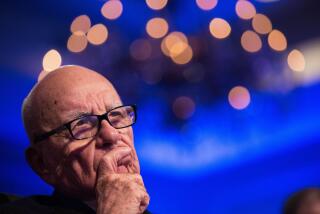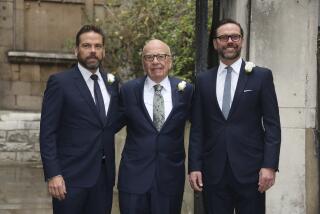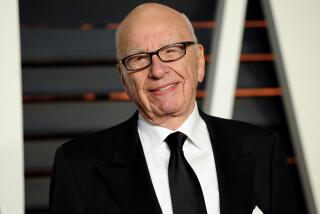Murdoch’s bid to buy Dow Jones accepted
- Share via
In locking up Dow Jones & Co. for $5 billion late Tuesday, Rupert Murdoch ensured that his vast influence would be felt in the business world for years to come -- as it is now by hundreds of millions of global TV viewers, moviegoers and Internet users.
News Corp.’s pending purchase of the parent of the Wall Street Journal puts Murdoch, its chairman, closer to fulfilling a years-long personal ambition: leveraging the most trusted name in business news into the world’s premier television, print and online provider of financial information.
Murdoch claimed his prize after separate board meetings of News Corp. and Dow Jones directors late Tuesday. The deal must still be approved by shareholders of both companies and by federal antitrust regulators.
In recent days, Murdoch swayed enough members of the Bancroft family, which has 64% of the voting power, to cede ownership of a company they have controlled since 1928.
Murdoch intends to use the Journal brand, its stories and its editorial talent in new ways, most urgently to fill a new cable channel he is launching this fall to rival CNBC. He promises to beef up the Journal’s editions in Asia and Europe. He wants the publication to cover more general and political news, positioning it as a head-to-head rival of the nationally circulated New York Times. He also plans to expand the Journal’s money-earning website.
Already, teenagers are among the 115 million global MySpace.com users whom Murdoch counts as his customers. So are the tens of millions of moviegoers worldwide who watched “The Simpsons Movie” in cinemas last weekend, the more than 30 million viewers who tuned in for last season’s “American Idol” finale on the Fox network and some 300 million viewers who subscribe to Star TV in Asia. His empire has secured the rights to sporting events worldwide, using such properties as the NFL in the U.S. and soccer overseas to garner audiences and popularize his TV channels.
“He owns more than 100 newspapers, an international empire in television, print and the Internet,” Boston University journalism expert Louis Ureneck said. “He’s everywhere.”
Veteran newspaper industry analyst John Morton called Murdoch a modern equivalent of William Randolph Hearst because of the extent to which News Corp. carries the 76-year-old billionaire’s imprint.
“Seldom do you see a businessman so closely identified with his empire,” Morton said.
For those who disdain the native Australian’s conservative politics, and for journalists who fear his potential meddling in editorial decisions, the news that Murdoch had finally completed the deal after nearly three months of public wrangling was greeted with resignation and dismay.
Recently, Murdoch has suggested that Journal stories should be shorter and less esoteric. In scores of letters to the Bancrofts, reporters portrayed Murdoch as someone with a history of selecting editors who would use their power to help advance Murdoch’s corporate interests.
“Dow Jones and the Wall Street Journal are just feathers in Murdoch’s cap -- but signal a disturbing trend for consumers who rely on media to be independent and diverse sources for news and information,” Gene Kimmelman, a vice president at Consumers Union, said in a statement Tuesday.
Officials from the Independent Assn. of Publishers’ Employees, which represents Journal employees, also expressed disappointment.
But analyst Josh Bernoff of Forrester Research in Boston said he didn’t expect Murdoch to meddle with the Journal’s news operations because its reputation is its most valuable asset.
“You don’t buy a Bentley and then go off-roading with it,” he said.
From the start, Murdoch’s checkbook and patience gave him the advantage in winning Dow Jones. His pursuit started informally earlier in the year when he got wind that the Bancrofts might be willing to sell for $60 a share, a price not seen in more than five years.
The News Corp. chairman asked Dow Jones Chief Executive Richard Zannino to breakfast in March. His first approach was rebuffed, but the margin of resistance grew smaller after Murdoch’s proposed terms leaked and the stock soared. Murdoch then met with the Bancrofts and agreed in writing not to fire the Journal’s top editors without the approval of an independent board.
By offering a 65% premium above what Dow Jones shares had been trading at before News Corp.’s bid became public, Murdoch all but eliminated any serious rivals and also made it virtually impossible for the Bancrofts to pass up his proposal. And, despite suggesting at times that he was frustrated and might walk away, it seemed clear Murdoch wasn’t going anywhere.
Dow Jones enjoys a rich history dating to 1882, when it was founded by three journalists. The Wall Street Journal first appeared in 1889, with the Dow Jones industrial average stock index debuting seven years later. In 1928, Hugh Bancroft became president and, with his wife, Jane, began the dynasty that has controlled the company to this day.
When everything was going well, Dow Jones ranked among the country’s most admired companies and the Bancrofts were toasted for their hands-off posture. The Journal consistently has been one of the world’s great newspapers.
But in recent years, as the company stumbled and the newspaper advertising market weakened, members of the Bancroft family began to wonder whether they had ceded too much control to their professional managers.
At the same time as Dow Jones shares sagged and some family members grew restless, Murdoch was plotting to challenge General Electric Co.’s CNBC business news channel. In February, he formally unveiled those plans.
Murdoch aims to use the Journal to build that new channel. Ownership of the second-largest U.S. paper by circulation, after USA Today, would give Murdoch an immense supply of stories and data about businesses, a profitable and still-growing part of a broader journalism world that has been shaken by the explosion in free, advertising-supported news websites.
One hurdle, however, is a deal under which the Journal provides resources to CNBC until 2012.
Murdoch likes the Journal’s business news because people are willing to pay for it online in a way they won’t pony up for news about City Hall, celebrities or bus crashes. Bernoff of Forrester Research called the Journal “sort of a hat trick”: a mass audience that generates online subscription fees with advertising its readers don’t mind. Murdoch has hinted, however, that he might consider making the website free of charge.
Still, Murdoch isn’t about building niche businesses. Rather, his pattern is to exploit assets in fresh ways for his company, which includes such newspapers as the New York Post, a collection of websites such as MySpace, the 20th Century Fox movie studio, the Fox network and the Fox News channel.
“He’ll no doubt project Dow Jones and the Wall Street Journal into other parts of his company in ways that we haven’t thought of yet,” Morton, the newspaper industry analyst, said.
Many of Murdoch’s own executives were skeptical of his pursuit of Dow Jones, believing that it was an expensive bet on old media at a time when new media is taking off. Newspapers are out of favor, with advertising and readership migrating to the Internet. Analyst Laura Martin of Soleil/Media Metrics said that Wall Street would watch closely to see how he justifies the price.
“The reason this is a big deal is that people are wondering whether Rupert sees something we are all missing from the upside of newspapers,” Martin said.
Murdoch is counting on growing demand for financial news worldwide as the economies of China, India, Russia and Latin America become stronger. There are few sources of reliable news and analysis in these emerging markets, where News Corp. already has made inroads. For instance, Murdoch was plotting entry to China before most other media companies. He was early in spotting India’s growing middle class and staking out TV channels there.
Since inheriting a small Australian newspaper business from his father more than 50 years ago, Murdoch has relished trampling on conventional wisdom. He built his global media empire in large part through deals that experts considered too risky, too expensive or both.
Few thought there was room for a fourth TV network in the 1980s when his Fox network took on ABC, CBS and NBC. Similar skepticism greeted the Fox News cable-TV channel when it challenged CNN, and his 2005 decision to pay $580 million for MySpace.com. Murdoch has had some big misses, such as the ill-fated investment in Hollywood-based Gemstar-TV Guide International.
Nonetheless, his hits have been big enough to give skeptics pause when he took his $5-billion swing at Dow Jones. Today, his personal net worth is estimated at $9 billion by Forbes.
Andrew Leckey, director of the Donald W. Reynolds National Center for Business Journalism at Arizona State University, said that Murdoch’s strength was his ability to look at properties dispassionately, then figure out where they fit into his vision, something Leckey expects him to do at Dow Jones.
“It was worth far more to him than it would be to others because he can do more with it,” Leckey said.
Menn and Bates reported from Los Angeles, Mulligan from New York.
--
(BEGIN TEXT OF INFOBOX)
What News Corp. gets from Dow Jones
- Wall Street Journal
- Barron’s magazine
- MarketWatch.com
- Dow Jones Newswires
- Dow Jones Indexes
- Factiva news database
- 28 small newspapers in California, Oregon and New England
--
(BEGIN TEXT OF INFOBOX)
$5 billion
What News Corp. is expected to pay for Dow Jones
$25.3 billion
News Corp.’s revenue in fiscal 2006
$9 billion
Rupert Murdoch’s estimated net worth
73
Murdoch’s rank on Forbes billionaires’ list
76
Murdoch’s age
2.6 million
Daily circulation of the Wall Street Journal in print and online
Source: Times research
--
(BEGIN TEXT OF INFOBOX)
The deal for Dow Jones
What News Corp. gets
New York-based Dow Jones & Co. is best known as publisher of the Wall Street Journal, the respected financial newspaper with 2 million print subscribers and a growing online business.
The company, founded in 1882, generated revenue of $1 billion in the year’s first half. It also owns Dow Jones Newswires, Barron’s, the Factiva electronic database, investment website MarketWatch and 23 small newspapers on the East Coast.
The company also licenses global stock market indexes including the Dow Jones industrial average.
Terms of the deal
Dow Jones stockholders, including the controlling Bancroft family, would get $60 a share in cash, a 65% premium to the closing price before News Corp.’s bid became public May 1.
A limited number of shareholders could exchange their stakes for News Corp. stock instead of cash to avoid taking a tax hit.
Upon completion of the deal, News Corp. assumes liability for as much as $30 million in fees that Bancroft family members owe advisors stemming from the three-month takeover fight.
The next steps
Both News Corp. and Dow Jones shareholders must approve the deal. Antitrust regulators must also weigh in. News Corp. Chairman Rupert Murdoch is expected to sell off the company’s small papers, focus on digital content and try to leverage the Journal’s brand name throughout his global media empire.
He hopes to use the paper to promote and provide content for News Corp.’s new Fox Business Channel, being launched in October. That might require patience because CNBC has a deal to use Journal reporters as on-air personalities until 2012.
Critics of Murdoch fear the magnate will threaten the Journal’s editorial independence, but Dow Jones and News Corp. have tried to allay those concerns by creating a five-person committee that would have to sign off on the hiring or firing of top editors. Murdoch, however, has veto power over new members of the committee when any of the existing ones retire.
Source: Times reporting
More to Read
Inside the business of entertainment
The Wide Shot brings you news, analysis and insights on everything from streaming wars to production — and what it all means for the future.
You may occasionally receive promotional content from the Los Angeles Times.










